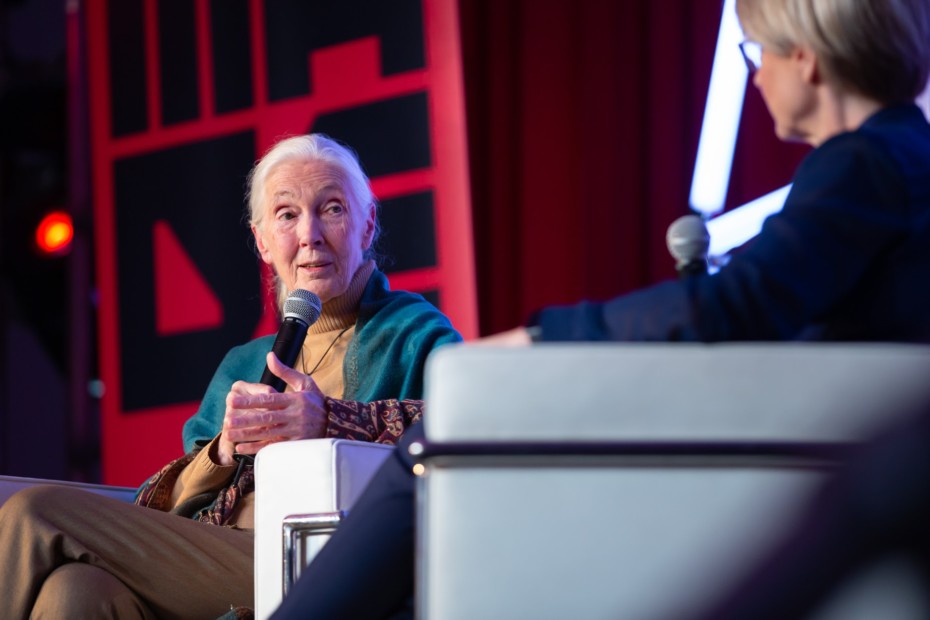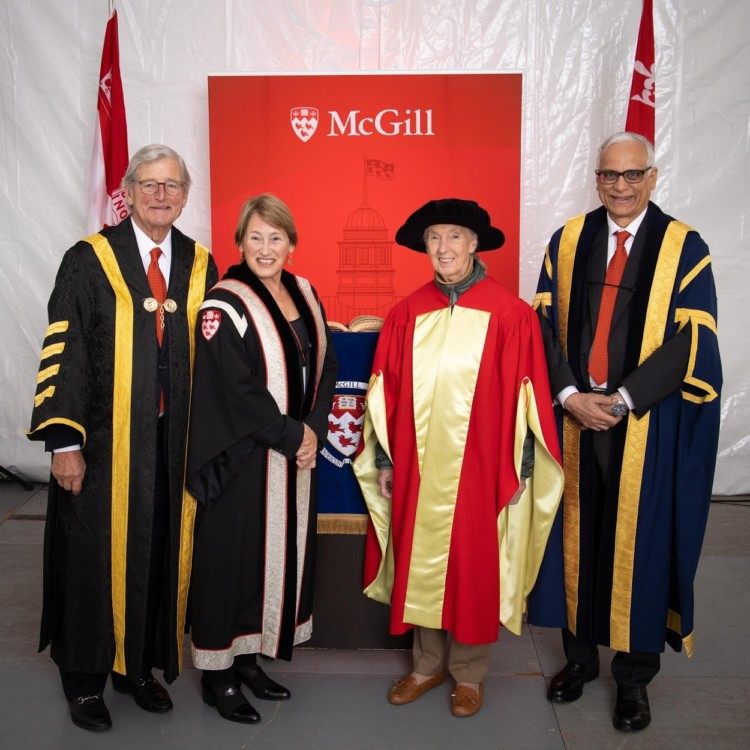
It was a moment that forever changed Jane Goodall’s life.
In the mid-1980s, Goodall, already one of the world’s leading experts on wild chimpanzees, had received permission to visit a series of medical research laboratories in the US. Genetically almost identical to humans, chimps were prime subjects for medical research, often being subjected to painful, sometimes lethal, experiments.
“I’ll never forget the first chimpanzee I saw in one of those 5×5 cages. He was an adult male. I was down on my elbow and he was looking out at me. Bare floor. People in white coats sticking needles in him. His name was Jojo,” she told the sold-out crowd at the 65th Beatty Lecture on September 26.
“As I looked at him, tears began to roll down my cheek. He reached out with a finger and gently wiped them away. That’s when I knew I had to do something,” she said. “And it’s been a long journey.”
The Tarzan Influence
That long journey began in England where, as Goodall told the audience, “I was born with a love of animals.”
As a toddler, that love of animals inspired Goodall to bring earthworms into her bed at night and quietly wait in the shadows of a chicken coop for four hours to solve the mystery of where eggs come from.
A voracious reader, the young Goodall spent much of her time with her nose buried in books like Dr. Doolittle and Tarzan of the Apes – with the latter serving as a blueprint to the life she yearned to lead. “I fell passionately in love with this glorious Lord of the Jungle… but what did Tarzan do? He married the wrong Jane,” Goodall said, eliciting good-natured laughter from the audience. “That’s what started my dream.
“I [wanted to] grow up, move to Africa, live with wild animals and write books about them,” she said. “Everybody laughed at me. ‘How will you do that?’ they said. ‘You don’t have money. Africa is far away. It’s a dangerous place. And, anyway, you’re just a girl. Girls don’t do that sort of thing.’”
But Goodall’s always-supportive mother insisted that no dream, no matter how lofty, is out of reach. “My mother told me ‘If you want something like this, you’re going to have to work awfully hard. You’re going to have to take advantage of every opportunity. But don’t ever give up.’”
From secretary to primatologist
Unable to afford university, Goodall took a secretarial course in London and worked as a clerk. All the while, she kept reading about animals and the natural world.
“Then came the opportunity,” said Goodall.

A friend living in Kenya invited Goodall to visit. “I couldn’t save money in London, so I went home, worked as a waitress in a hotel around the corner… It was the start of the World War II, people didn’t have much money so the tips were small.”
It took Goodall five months (“maybe more”) to earn enough money to buy passage aboard a boat for the month-long trip to Kenya.
While in Kenya, Goodall was convinced by friends to contact the famous paleontologist and anthropologist, Louis Leakey, who was then curator of the Coryndon Museum in Nairobi. It so happened that Leaky was looking for a new secretary. “I went to see him at the museum. He showed me around and asked me hundreds of questions,” she said. “I think he was impressed by how much I knew… That’s because I had read every, single book I could about African animals and I had spent hours in the Natural History Museum in London.”
Eventually, Leaky offered Goodall the job she had been dreaming of her entire life – not to file his reports and send memos, but to study chimpanzees at Gombe Stream National Park in Tanzania.
“People thought he was crazy,” she said. “A young girl who hadn’t been to college… and he wanted me to go to a remote forest in Africa to study chimpanzees – something nobody had done before.”
It was at Gombe that Goodall realized her lifelong dreams. While it took time, eventually, she was accepted by a local troop of chimpanzees to the point where mothers trusted her with their babies. No other researcher had been able to get so close to the normally elusive primates.
A star is born
This privileged access paid huge dividends, as Goodall made a series of discoveries that turned previously held truisms of chimpanzee – and human – behaviour completely on their head.
She was the first researcher to observe chimpanzees fashioning and using tools – a skill previously thought to be the domain of humans alone. She also discovered that chimps, once thought to be herbivores, eat and hunt for meat. Her long-term studies also revealed that chimpanzees have similar social behaviour to humans and that each troop has a distinct “culture” that is passed down from one generation to the next.
And, thanks to National Geographic – which funded her research on the condition that their photographer could record it in film and photographs – Goodall became a global star, the human face behind primate research.
That stardom was also enjoyed by the Gombe chimpanzees, with updates of the troop and its members, including Flo, baby Flint and David Greybeard, appearing regularly in the pages of National Geographic magazine. While the public fell in love with the chimpanzees, researchers criticized Goodall giving the chimps names instead of numbers as being “unscientific.” Others accused her of excessive anthropomorphism.
Goodall ignored the critics. The National Geographic funding gave her the unique opportunity to live in close proximity to the chimpanzees for decades. “I was able to settle down and really give myself in to this forest world and get to understand the chimpanzees and their behaviour better and better,” she told the audience. “And the thing that was so striking was how like us they really are…
But even though, in her own words, she was living “the best days of my life,” Goodall had her “Damascus moment,” at a conference in 1986, where she listened to experts outlining the serious threats faced by wild chimpanzees – hunting, deforestation and human encroachment. The thing that horrified her most was knowing that chimps were being subjected to inhumane medical testing.
“When I went to that conference, I was a scientist,” she said. “When I left, I was an activist.”
Change through knowledge
Goodall learned that to advocate for chimpanzees was to advocate for the very people who were threatening them. “At the same time, I was learning what was happening to so many of the humans living in and around the chimpanzee habitat,” she said. “The crippling poverty. The lack of good health and education facilities. The degradation of the land. How can we help chimpanzees if people are struggling to survive?” she asked the audience.
Initially at a loss as to how to approach the myriad of diverse and difficult issues, Goodall turned to the thing she understood best; knowledge. Arm people with knowledge and let them help themselves. “That’s when the Jane Goodall Institute (JGI) started the TACARE, or Take Care, Program,” she said.
Launched in 1994, the program partners with local inhabitants to create sustainable livelihoods while promoting environmental protection. TACARE achieves conservation results by first consulting communities about their needs and priorities, working together to collaboratively design the future rather than imposing outside solutions.
“It’s community-based conservation,” said Goodall. “A tiny team of local Tanzanians went into the six local villages bordering Gombe – not a group of arrogant white people telling them what to do. It was local people who asked ‘what can we do to make your lives better?’”
Farmers were taught techniques to improve crop fertility without chemicals. Water management programs were introduced, as were microcredit programs, particularly for women. “For the first time, women can take out tiny loans for environmentally sustainable projects like buying seedlings for a tree nursery,” said Goodall.
In addressing overpopulation, the JGI began offering scholarships to girls because “around the world it has been shown that, as women’s education improves, family size tends to drop.”
Clinics were opened where women could learn about reproductive health and how to care for their babies when they were sick. “They eagerly accepted family planning information,” said Goodall.
Gradually the programs expanded from the original six villages, to 52. Today, 104 Tanzanian villages are supported by JGI programs. Improved food production and reforestation have proved beneficial for local chimpanzee populations. “I can say absolutely that there are chimpanzees in the wild today that would not be here if these programs hadn’t been introduced.”
Holding on to hope
Toward the end of her lecture, Goodall asked the question of herself that many in the audience were thinking. “Do I really have hope for the future? I’ve seen so much cruelty. I’ve seen refugees have to leave their homes because of violence or climate change. I’ve seen forests cut down. I’ve seen little chimpanzees for sale in the market. I’ve seen so much suffering and destruction…” said Goodall.
But, she does still have hope, citing nature’s resilience, the “indomitable human spirit,” and our intellect – “although it is bizarre how the most intellectual creature that ever walked the planet is destroying it’s only home.”
Her main reason for hope lies in today’s youth. “When young people understand and we listen to their voices and empower them to action,” she said “they are changing the world.”
